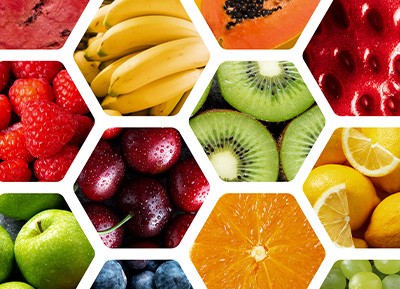Exploring the Impact of the Biological Ripening Process on the Food Industry
By Patricia Sánchez Carrillo
Supermarkets and greengrocers offer a wide variety of fruit and vegetables, which we usually like to buy at their optimum point of ripeness. However, this is not always possible and many times we buy unripe fruit which will then finish ripening at home. Fruit sellers recommend that we store this green fruit on paper or plastic, at room temperature, but have you found that this green fruit often never ripens at home? This is not abnormal, it's just that this fruit hasn't finished its biological ripening process correctly.
What Types of Fruits Are There According to Their Type of Ripeness?
Distinguishing between climacteric and non-climacteric fruits is crucial. Climacteric fruits continue ripening after harvest while non-climacteric fruits do not; they need to be on the tree or plant to ripen. This is why when we buy certain green fruits, they never ripen at home. Examples of climacteric fruits include apples, pears, bananas, kiwis, tomatoes, and peaches. Non-climacteric fruits include oranges, lemons, grapes, and pomegranates.
The distinction between climacteric and non-climacteric fruits hinges on the critical role of ethylene in the ripening process. Ethylene, recognised as the primary hormone responsible for ripening, is a gaseous unsaturated hydrocarbon. Its natural biosynthesis escalates with the ripening progression in climacteric fruits, orchestrating notable changes in colour, aroma, and texture. In the case of climacteric fruits, ethylene levels persistently rise even after harvest, facilitating the completion of the ripening process at home. Conversely, non-climacteric fruits lack the inherent capability to produce ethylene post-harvest, resulting in their inability to autonomously ripen at home.
"Understanding the biological ripening process is crucial for the food industry, particularly in preserving fruits and vegetables. Traditional methods involve controlling temperature, humidity, and gas composition, but their application will depend on the type of fruit."
What Changes Does Ethylene Cause in Fruits?1
As mentioned above, ethylene is the hormone responsible for ripening. Due to its biosynthesis there are changes in the coloration of fruits. Chloroplasts undergo degradation and chlorophyll, the green pigment that lends its coloration to unripe fruit, is reduced. Simultaneously other pigments begin to be synthesized, such as carotenoids responsible for orange and yellow colours and anthocyanins responsible for the red, purple, and blue colorations typical of ripe fruit.
Alterations in smell and taste also occur. The sweet taste of ripe fruits is due to the hydrolysis of starch that generates sugars such as glucose, fructose, and sucrose. The formation of these sugars is due to a respiratory process in which organic acids are used, also decreasing the acidity of ripe fruits. As a consequence of this catabolic process, volatile phenolic compounds are produced responsible for the smell of ripe fruits.
Finally, fruits also lose texture, as ethylene activates the enzymes polygalacturonase and cellulase, which break down the cell wall of cells, leading to a reduction in fiber content.
How Does Knowledge of the Biological Process of Ripening Help the Food Industry?
Understanding the biological ripening process is crucial for the food industry, particularly in preserving fruits and vegetables. Traditional methods involve controlling temperature, humidity, and gas composition, but their application will depend on the type of fruit.
Currently, the biotechnology industry is seeking innovative approaches to genetically control the ripening of fruits. As previously mentioned, non-climacteric fruits exhibit a distinct ripening pattern, ceasing the process upon harvest and discontinuing ethylene production. However, ongoing studies focus on understanding the hormones responsible for inducing ripening in non-climacteric fruits. An illustrative example is the investigation into the Ripening Inducing Factor (RIF) protein that regulates genes involved in the ripening process of strawberries. This research encompasses various aspects, including the genes accountable for anthocyanin production, which impart the characteristic red color to strawberries, and the synthesis of abscisic acid, a hormone intricately linked to the ripening of non-climacteric fruits.2
Chemical methods for retarding ripening have been explored, as evidenced by a study conducted to assess the delay in the ripening of apricots and peaches. In this investigation, ethylene was effectively eliminated through a process involving oxidation with potassium permanganate and exposure to UV radiation. This method demonstrated the ability to postpone ripening, consequently leading to a preservation of the antioxidant capacity of these fruits.3
Understanding biological processes underpins various techniques employed in the food industry, including the preservation of fruits and vegetables through controlled ripening. The next time you visit the greengrocer, your perspective on bananas, strawberries, and kiwis may change. Interestingly, kiwis are slow-ripening, climacteric fruits. If you purchase them while still very green, consider giving them an extra boost of ethylene. Simply place the kiwis alongside a ripe banana and/or apple in a paper bag. The ethylene emitted by bananas and apples will accelerate the ripening of your kiwis. Are you up for trying this handy trick?
Explore the solutions we offer on our dedicated webpage Food Safety, Beverages and Agriculture
References
1. Hernández C., Bedoya G. 2014. Role of ethylene in the ripening of fruits. Ethylene tests with bananas. Universidad Católica Sedes Sapientiae. Biological Research Center. 13:4-7.
2. Martín-Pizarro C., Vallarino J.G., Osorio S., et al. 2021. The NAC transcription factor FaRIF controls fruit ripening in strawberry. The Plant Cell. 33(5), 1574–1593.
3. Alonso-Salinas R., López-Miranda S., Acosta-Motos J.R. Effect of the combination of ethylene removal methods on the antioxidant activity of apricot and peach. 2022. Advances in ripening and post-harvest of fruits and vegetables. 194-198.


